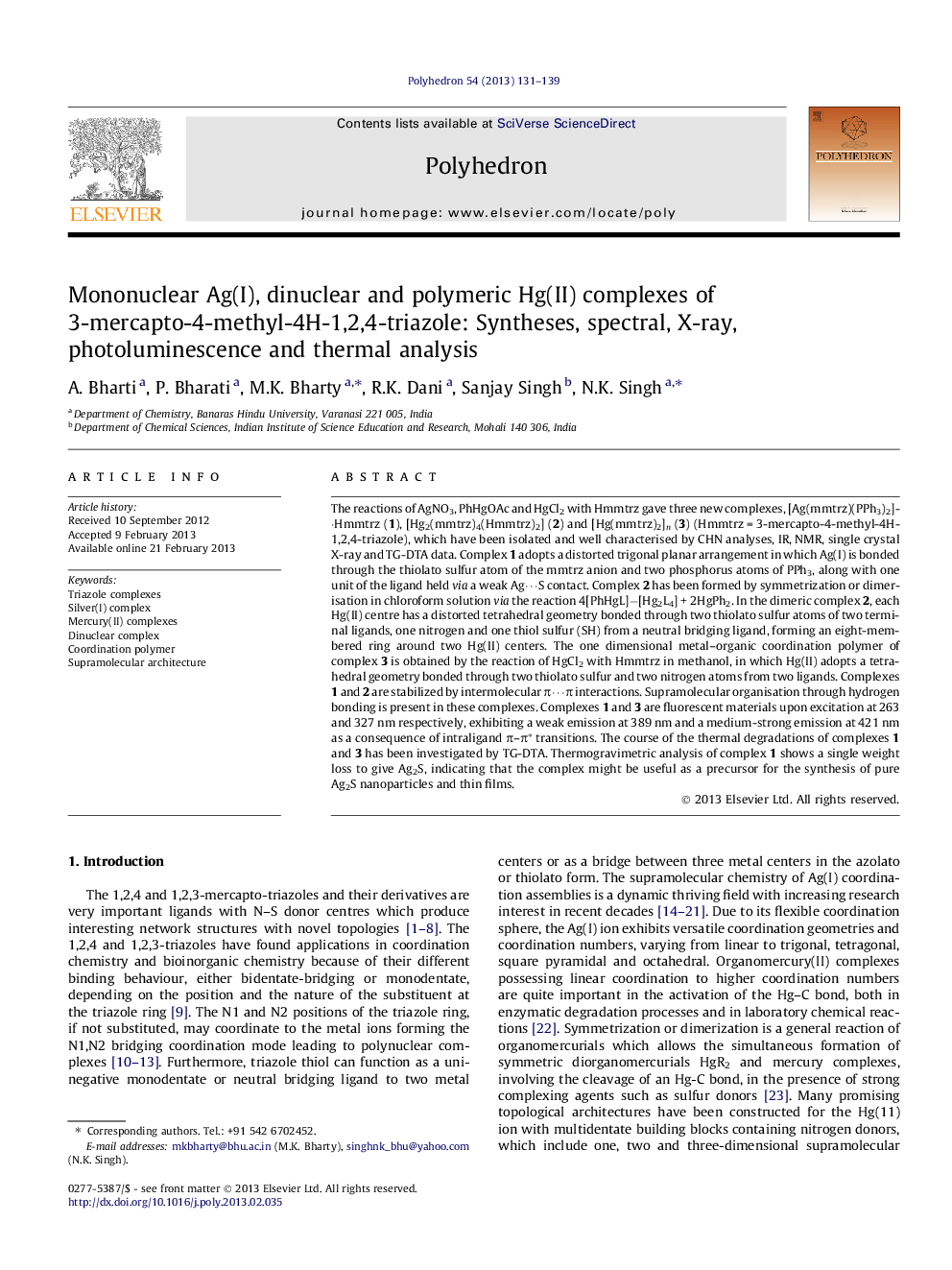| کد مقاله | کد نشریه | سال انتشار | مقاله انگلیسی | نسخه تمام متن |
|---|---|---|---|---|
| 1334590 | 1500285 | 2013 | 9 صفحه PDF | دانلود رایگان |

The reactions of AgNO3, PhHgOAc and HgCl2 with Hmmtrz gave three new complexes, [Ag(mmtrz)(PPh3)2]·Hmmtrz (1), [Hg2(mmtrz)4(Hmmtrz)2] (2) and [Hg(mmtrz)2]n (3) (Hmmtrz = 3-mercapto-4-methyl-4H-1,2,4-triazole), which have been isolated and well characterised by CHN analyses, IR, NMR, single crystal X-ray and TG-DTA data. Complex 1 adopts a distorted trigonal planar arrangement in which Ag(I) is bonded through the thiolato sulfur atom of the mmtrz anion and two phosphorus atoms of PPh3, along with one unit of the ligand held via a weak Ag⋯S contact. Complex 2 has been formed by symmetrization or dimerisation in chloroform solution via the reaction 4[PhHgL]−[Hg2L4] + 2HgPh2. In the dimeric complex 2, each Hg(II) centre has a distorted tetrahedral geometry bonded through two thiolato sulfur atoms of two terminal ligands, one nitrogen and one thiol sulfur (SH) from a neutral bridging ligand, forming an eight-membered ring around two Hg(II) centers. The one dimensional metal–organic coordination polymer of complex 3 is obtained by the reaction of HgCl2 with Hmmtrz in methanol, in which Hg(II) adopts a tetrahedral geometry bonded through two thiolato sulfur and two nitrogen atoms from two ligands. Complexes 1 and 2 are stabilized by intermolecular π⋯π interactions. Supramolecular organisation through hydrogen bonding is present in these complexes. Complexes 1 and 3 are fluorescent materials upon excitation at 263 and 327 nm respectively, exhibiting a weak emission at 389 nm and a medium-strong emission at 421 nm as a consequence of intraligand π–π∗ transitions. The course of the thermal degradations of complexes 1 and 3 has been investigated by TG-DTA. Thermogravimetric analysis of complex 1 shows a single weight loss to give Ag2S, indicating that the complex might be useful as a precursor for the synthesis of pure Ag2S nanoparticles and thin films.
Three new complexes, [Ag(mmtrz)(PPh3)2]·Hmmtrz (1), [Hg2(mmtrz)4(Hmmtrz)2] (2) and [Hg(mmtrz)2]n (3), derived from 3-mercapto-4-methyl 4H-1,2,4-triazole (Hmmtrz) have been synthesized and structurally characterised. Ag(I) adopts a distorted trigonal planar arrangement in which Ag(I) is bonded through the thiolato sulfur atom of the mmtrz anion and two phosphorus atoms of PPh3, along with one unit of the ligand held via a weak Ag⋯S contact. In the dimeric unit of complex 2, each Hg(II) centre has a distorted tetrahedral geometry, bonded through two thiolato sulfur atoms of two terminal ligands, one nitrogen and one thiol sulfur atom (SH) from a neutral bridging ligand forming an eight-membered ring. In the polymeric unit of complex 3, the Hg(II) ion is bonded to two thiolato sulfur and two nitrogen atoms from two ligands, possessing a tetrahedral geometry. Thermogravimetric analysis of complex 1 shows a single weight loss to give Ag2S, indicating that the complex might be useful as a precursor for the synthesis of pure Ag2S nanoparticles and thin films.Figure optionsDownload as PowerPoint slide
Journal: Polyhedron - Volume 54, 30 April 2013, Pages 131–139